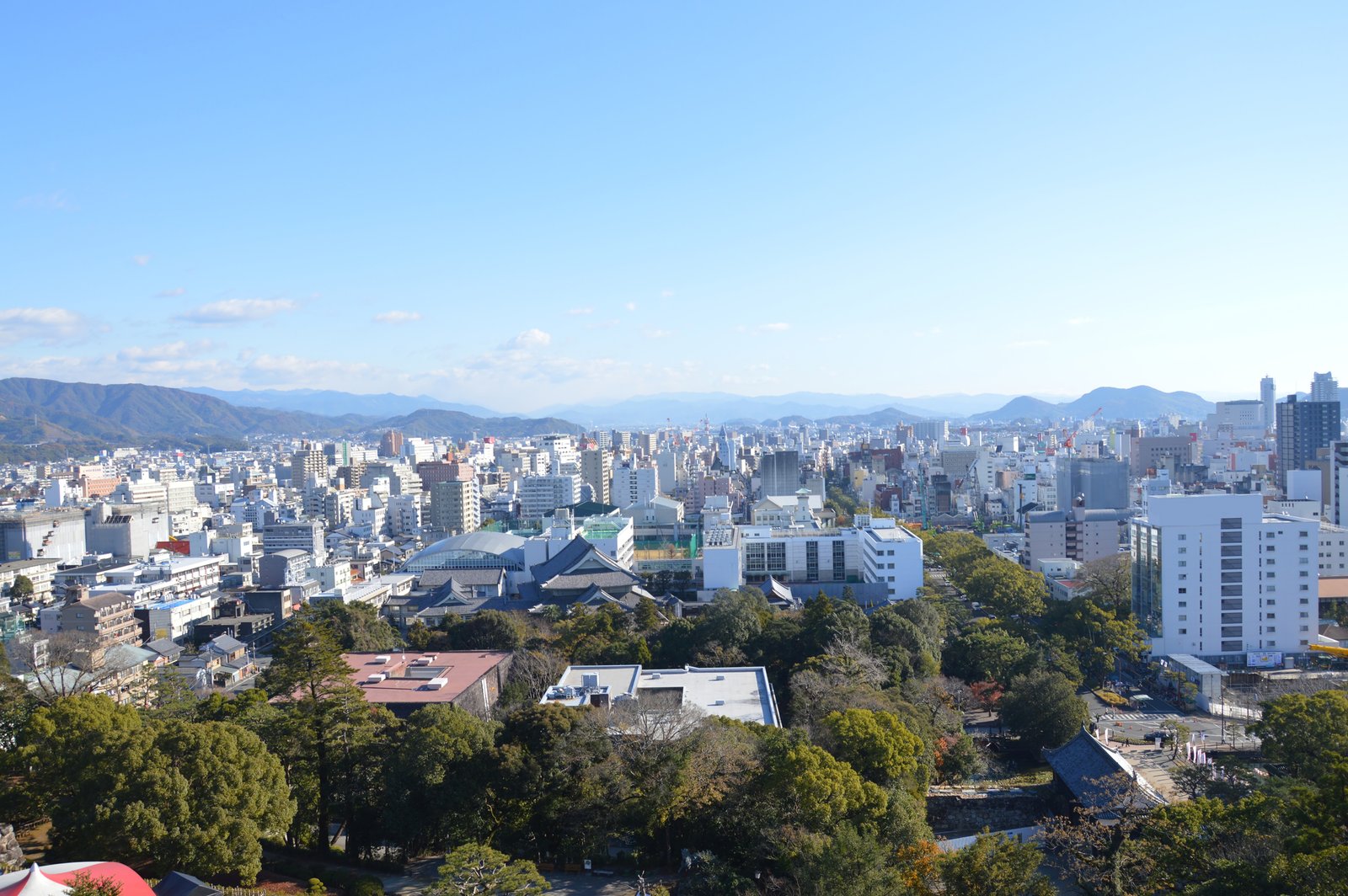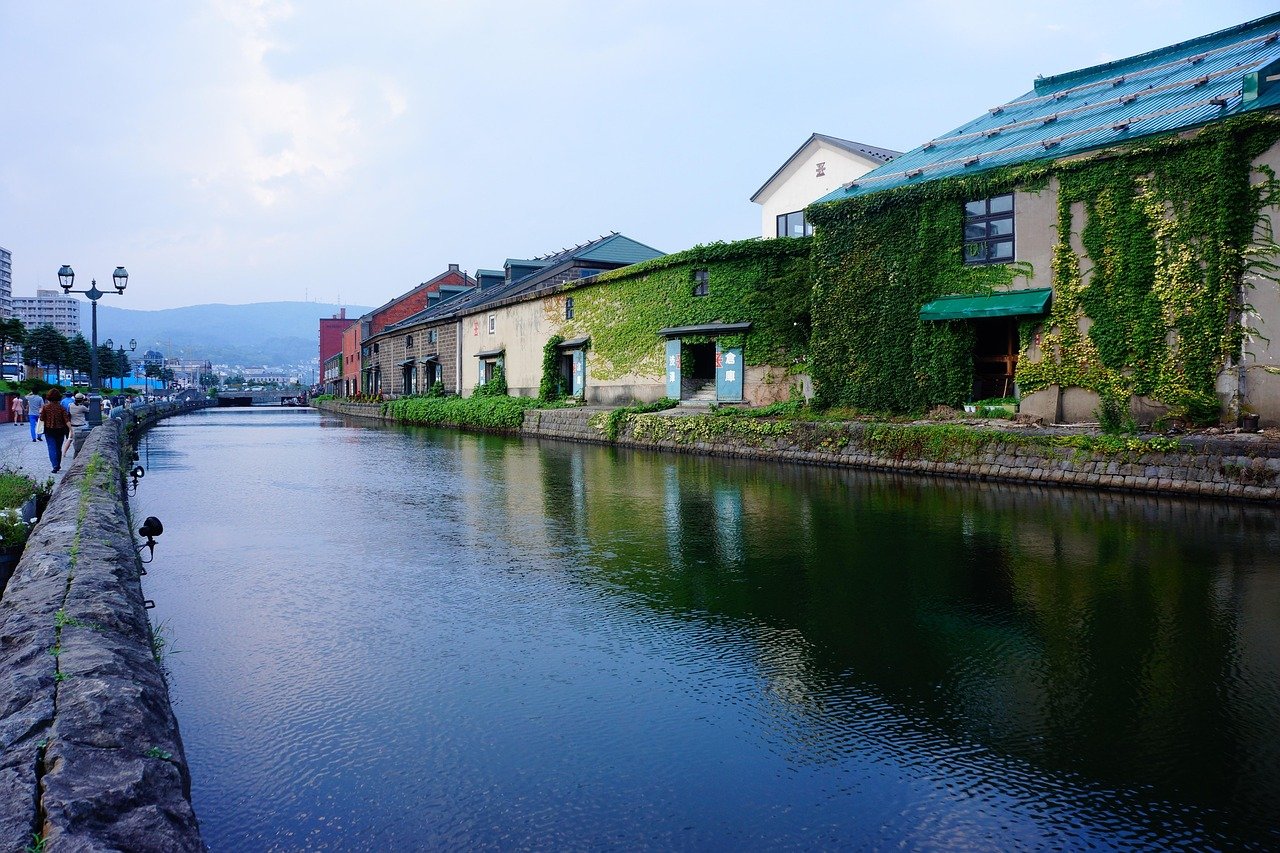Your first taste of Kochi bonito tataki changes your view of Japanese food. Located on Shikoku’s coast, mixes mountain and sea flavors in surprising ways. This food guide is more than just about fish. It’s a trip through a place where every food has a story, from yuzu to fresh catches.
Tokyo may be known for its Japanese cuisine innovation, but Kochi is about tradition. Here, food is made with care: aged miso, slow broths, and fresh bonito. This is food tourism Japan at its truest, where meals tell stories of land and history.
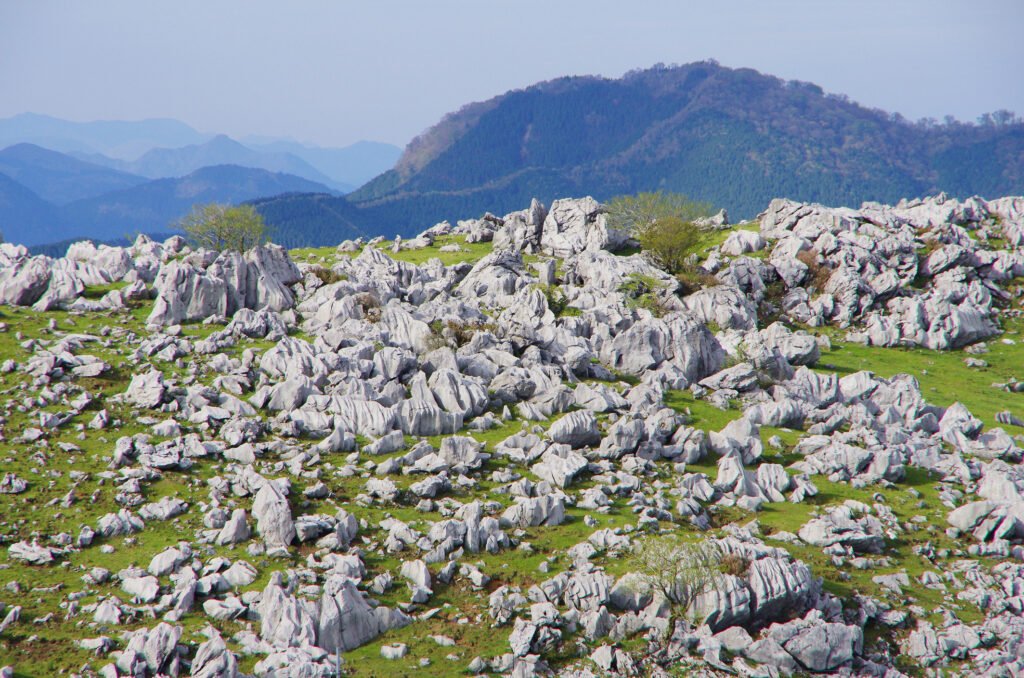
Karst Topography Called Shikoku Karst In Shikoku, Japan
Key Takeaways
- Kochi’s cuisine goes beyond its famous bonito, with a rich mix of flavors from the land.
- For centuries, culinary traditions have mixed new ideas with old ways.
- Discover food tourism in this city, with its changing seasons and fresh produce.
- Local spots, from family stalls to Michelin-starred places, show city’s hidden food treasures.
- This food guide invites you to enjoy dishes that reflect the region’s beauty and warmth.
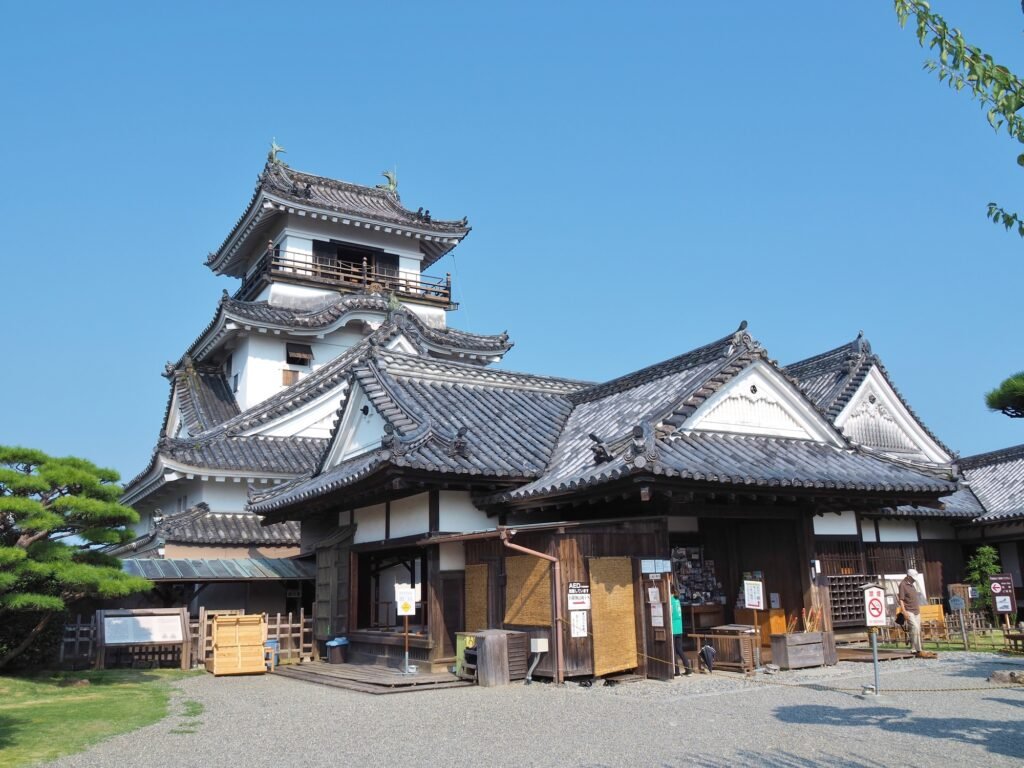
Kochi Castle, Prefecture, Japan.
Introduction to Kochi’s Gastronomic Landscape
Stepping into this city is like opening a time capsule of flavors untouched by modernity. This region is nestled between rugged mountains and a wild coastline. Its Kochi gastronomy thrives on stories passed through generations.
The scent of sun-dried bonito flakes, the tang of yuzu orchards, and the whisper of ancestral cooking techniques form the soul of its culinary identity.
“Here, food is memory. Every bite carries the weight of centuries,” says Chef Sato of city’s historic Katsurahama district, as you sip a tea infused with local myoga shoots.
The Historical Evolution of City’s Food Culture
Kochi food history is etched in its geography. Isolation bred ingenuity; fishermen developed sun-drying methods to preserve catches; mountain dwellers fermented vegetables in earthenware. These traditions, now celebrated as Japanese regional cuisine, reveal a culture where scarcity birthed artistry.
Your journey through old fishing villages reveals how even today, chefs revere centuries-old recipes like katsuo no tataki, seared bonito. It’s serves with the same reverence as in the Edo era.
What Makes Kochi’s Cuisine Unique in Japan
| Aspect | Kochi’s Approach | Contrast with Other Regions |
|---|---|---|
| Flavor Profile | Bold, unapologetic umami | Milder, sweeter notes dominate elsewhere |
| Preservation | Solar drying, citrus marinades | More reliance on soy/sake-based methods |
| Seasonality | Rigid adherence to peak harvest times | Flexible, market-driven availability |
Why Kochi Deserves a Spot on Every Foodie’s Bucket List
Imagine yourself tasting unique Japanese food where every dish tells you a story. You stroll through midnight markets, picking up freshly-caught tataki, and wander through terraced yuzu groves that seem to whisper secrets of the land. In this city, you don’t just eat, you experience. The cuisine isn’t just about flavors for you; it becomes a living archive of survival and celebration that you’re now part of.
When you sample kochi-style oden stewed in local shochu, you understand why this region whispers secrets that even Tokyo’s gourmet spots can’t replicate.
The Kingdom of Bonito: Kochi’s Culinary Crown Jewel
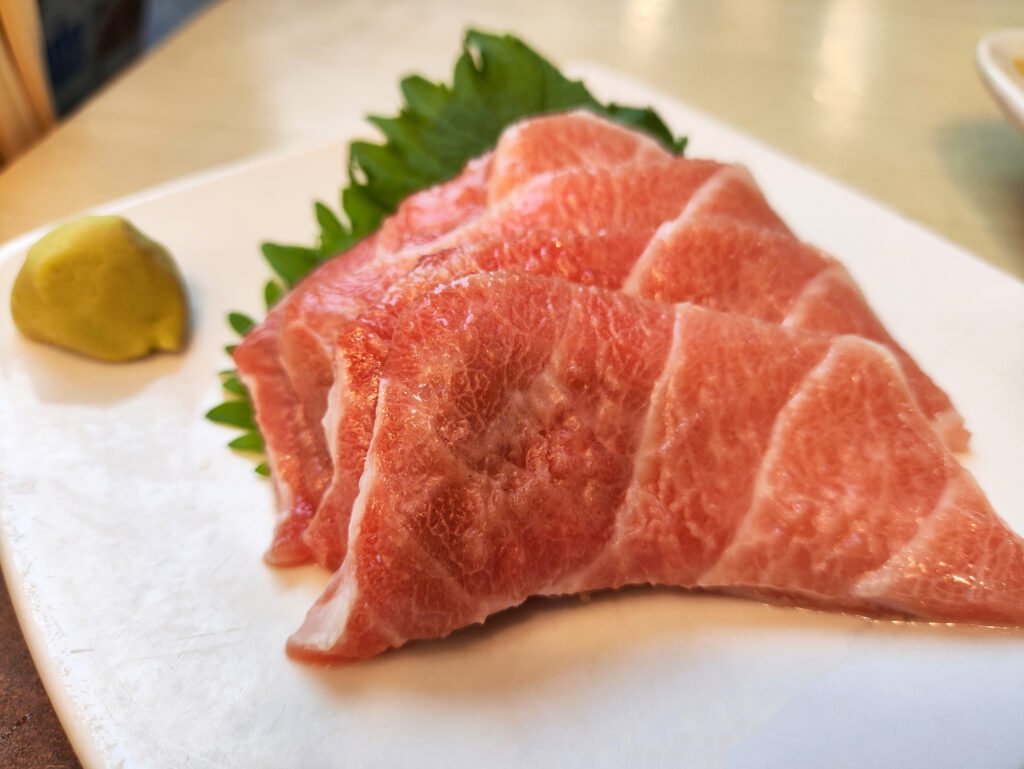
Fatty Tuna Sashimi Otoro Raw Food. Otoro Sashimi (Bluefin Tuna Belly)
In this city, the bonito is more than a fish—it’s a cultural symphony. Your journey begins at a riverside stall where fishermen share stories of bonito migrations. The artistry of Japanese bonito dishes begins with tataki preparation, a ritual and technique.
Over charcoal fires, chefs sear the fish until its surface crackles. This reveals a rare core that melts like silk. This method, passed down through generations, ensures every bite honors the fish’s essence.
Tataki: The Art of Searing Bonito
- Charcoal-grilled edges create a smoky crust
- Serviced with citrusy ponzu and ginger for balance
- Presented on cedar wood to evoke forest freshness
Seasonal Variations in Bonito Preparations
| Season | Preparation | Flavor Profile |
|---|---|---|
| Spring | Sashimi with mountain herbs | Fresh, buttery texture |
| Autumn | Simmered in kelp broth | Deep umami depth |
Unforgettable Taste of Fresh Bonito
At a misty dawn market, you see fishermen unloading shimmering seasonal Japanese seafood. The first taste of bonito tataki is unforgettable. Its seared surface gives way to oceanic sweetness.
Every bite is a dialogue between fire and sea, tradition and terroir.
A Complete Culinary Tour of Kochi Japan: Where Tradition Meets Innovation
Exploring the culinary tour of this city is like walking through a world of flavors. Here, food experiences mix old traditions with new ideas. From the early morning at Tsunoshima Market to the lively izakaya at night, every moment is a story.
“We don’t just cook food, we preserve stories,” explain Chef Sato of Ryugin, whose katsuo tataki with yuzu gelée reimagines tradition. “Innovation honors heritage when rooted in respect.”
- Morning: Follow the city dining guide to morning markets, where mist clings to fish scales.
- Afternoon: Enjoy kombu-infused tea at old noodle shops, where broths simmer over charcoal.
- Evening: Visit Yuzu no Sato for Japanese food tourism, where a Michelin-starred chef mixes ancient sashimi with modern twists.
In this city, every bite is a conversation. At Udonya, a 128-year-old stall, you see octogenarians kneading dough with skill passed down through generations. Yet, Teruteru Bazaar nearby uses city’s famed yuzu in sorbets and cocktails, showing how old and new can blend.
If you’re seeking a deeper experience, Epicurean Escape’s Kochi itineraries show the region’s heart. Here, a single katsuo fillet can connect past and present, making every meal a shared secret.
The Vibrant Tapestry of City’s Seafood Scene
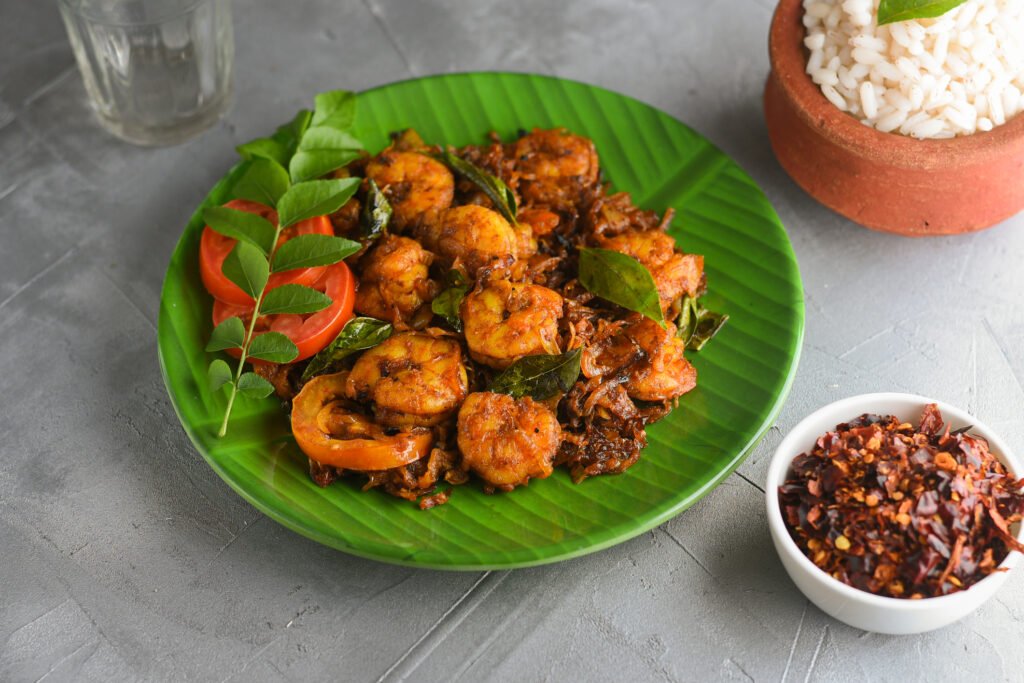
Kerala Prawns, Chemmeen Roast Shrimp Fry Indian Fish Curry. Kerala Fish Curry Prawns, Chemmeen Roast Shrimp Fry Spicy Prawns Masala In Banana Leaf Plate
Kochi’s waters offer a world of flavors beyond just bonito. The Kuroshio Current brings nutrients that make kinmedai and sawara tender and rich. These seafood specialties are celebrated in dishes from sashimi to grilled delights.
On a dawn boat ride with a fifth-generation fisherman, you see how fishing traditions respect the sea. Every catch is a tribute to the ocean’s generosity.
- Kinmedai: Golden eye snapper, its flaky flesh ideal for steaming with citrusy yuzu.
- Sawara: Firm, oily-rich mackerel grilled to caramelized perfection.
- Muroto Cape Lobster: Sweet, succulent tails caught via trap methods minimizing seabed disruption.
Tracing the Tides of Sustainability
Old fishing traditions meet modern science to protect fish stocks. Fishermen like Mr. Sato, whose family has fished here for 130 years, use GPS and lunar cycles. These methods support sustainable fishing Japan.
| Aspect | Traditional Methods | Modern Innovations |
|---|---|---|
| Harvest Timing | Seasonal moon phases | Acoustic population surveys |
| Bycatch Mitigation | Hand-sorting nets | Biodegradable traps |
Touching a fresh kinmedai that morning, you feel the weight of tradition. This mix of old and new keeps city’s seafood rich and sustainable.
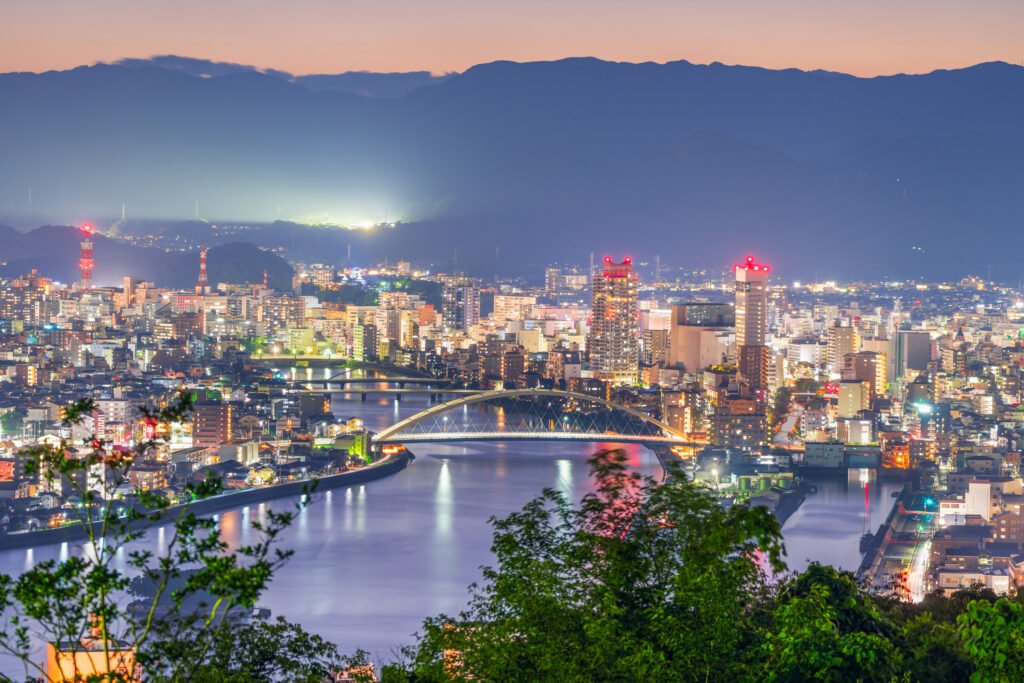
Japan Downtown City Skyline At Dusk. Kochi, Shikoku
The Soul of Kochi: Local Markets and Street Food Experiences
Walking through Kochi’s Sunday Market, You feel like time has stopped. Standing in the heart of this food market, you realize you’ve discovered a treasure that’s been around for centuries. It’s here that flavors come alive for you—vibrant, rich, and deeply rooted in tradition.
Stalls overflow with Japanese street food delights. You can find smoky katsuo no tataki donburi, flounder tempura, and earthy inaka soba.
“Every ingredient here tells you a story,” says a third-generation vendor, her hands shaping sticky mochi rice cakes. “These local markets Japan are our libraries—where recipes are passed like heirlooms.”
In the midst of the hustle, you find hidden gems. There are yuzu-kissed pickles and sun-dried bonito flakes.
The market’s rhythm comes from simple moments. Like when a vendor shares his family’s miso with you. Or when a fishmonger tells stories of tides and harvests.
These food markets are more than just places to buy food. They are living stories of city’s culinary heart.
- Flame-seared Japanese street food stalls
- Seasonal produce arranged like edible art
- Generational vendor families sharing heirloom recipes
Every bite here connects you to city’s history. The Sunday Market is a place where tradition meets hunger. It’s where travelers find real authenticity.
Farm-to-Table Experiences: Kochi’s Agricultural Bounty
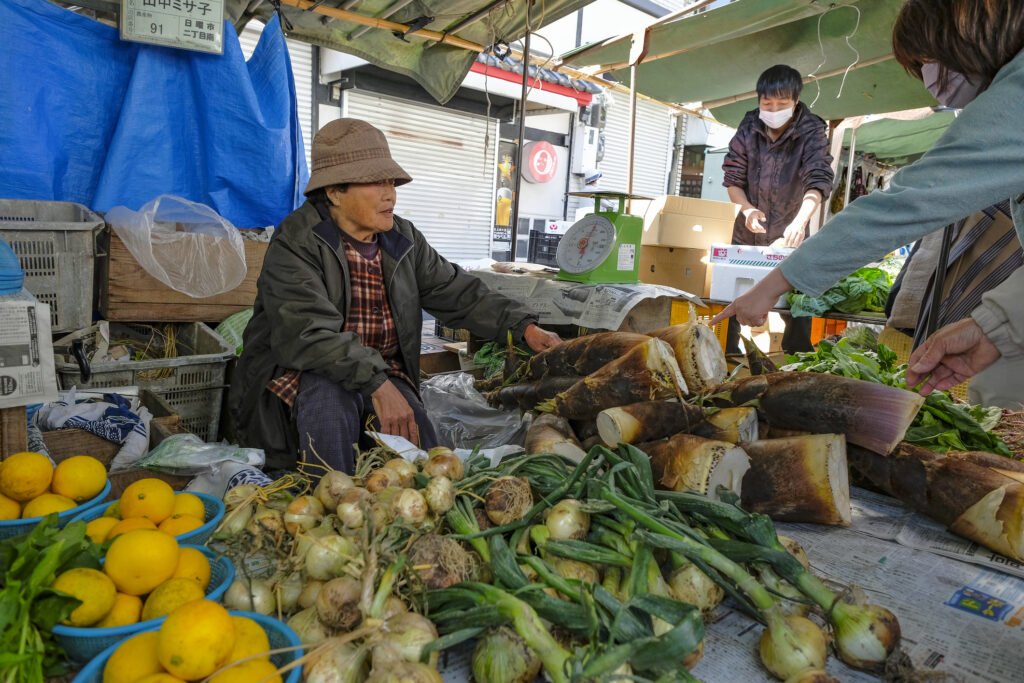
Kochi, Japan – April 9,2023: A Woman Selling Fruits And Vegetables At The Sunday Market
Yuzu and Citrus Fruits: Kochi’s Fragrant Offerings
The scent of Kochi yuzu fills the air in terraced orchards. These citrus fruits grow in cool mountain air. They add flavor to sashimi, season ponzu, and scent winter baths.
But there’s more than yuzu. This city also has konatsu and buntan pomelo. These show how diverse Kochi’s citrus is and shape its food.
Seasonal Japanese Vegetables That Define Kochi’s Cuisine
Seasonal Japanese vegetables add beauty to Kochi’s dishes. Here are some:
- Myōga ginger: Adds floral heat to summer soups
- Sansai wild vegetables: Foraged greens in mountain dishes
- Tosa red peppers: Smoky autumn staples in stews
Your Personal Encounters with Kochi’s Farmers and Producers
At a misty morning market, Tanaka-san gives you a warm Kochi yuzu. He talks about his family’s four-generation methods. Nearby, Yamamoto-san shows his work in reviving orchards. His story shows how farmers connect tradition and modernity.
The Liquid Spirit of Kochi: Sake, Shochu, and Local Beverages
In Tosa’s misty valleys, sake shines with crisp elegance. Pure mountain streams and special rice like Yume no Yuki create a Japanese rice wine that’s both dry and umami-rich. At traditional Tosa breweries, brewers follow ancient rituals, chanting over kettles.
The traditional Japanese drinks here have a story to tell. A sip of sake brings the sea breeze to your lips, a reminder of the ocean nearby.
- Sake: Dry, mineral-driven profiles from breweries like Yuzukura in Nankoku
- Shochu: Sweet potato varieties with earthy undertones, distinct from Kyushu’s versions
- Fruit liqueurs: Yuzu-infused spirits capturing the citrus groves of Mount Tsurugi
“A glass is never alone here. It’s a conversation starter, a bridge between strangers.”
In Kochi’s izakayas, the vibe is all about togetherness. At moonlit festivals, elders share cups crafted in Tosa brewing traditions. Their laughter mixes with roasted kusu(local chestnuts) and warmed shochu. Here, drinks are more than a taste—they’re a way to celebrate the land.
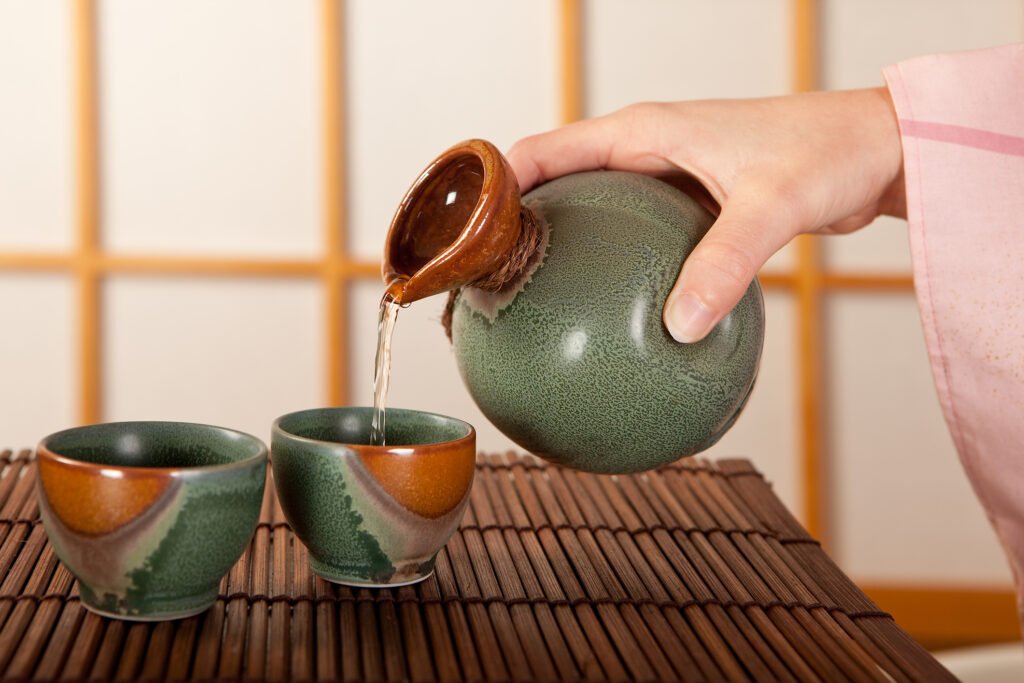
Pouring Sake. Female Hand Pouring Two Cups Of Japanese Sake
Hidden Gems: Off-the-Beaten-Path Eateries Worth Discovering
Guidebooks often focus on city’s famous dishes. But the real magic is in the hidden eateries where locals meet. These hidden restaurants offer authentic Japanese dining experiences untouched by tourists. Your journey shows you places where time stands, and every dish has a story.
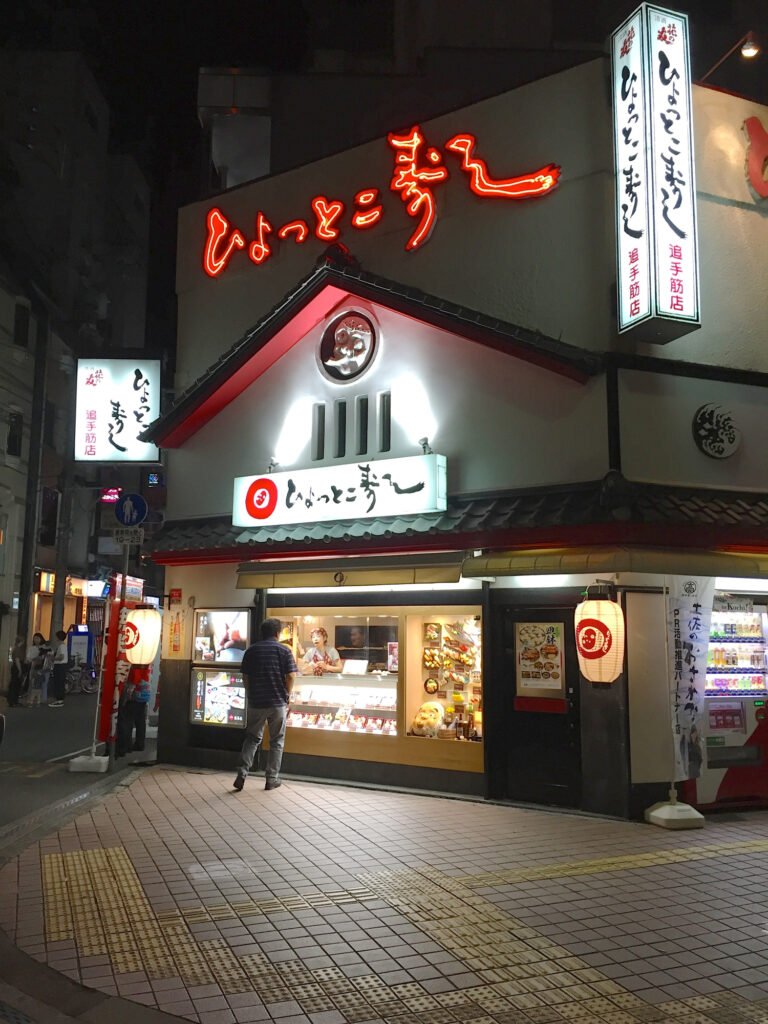
Kochi, Shinkoku, Japan – 17Th August 2018 : View On A Typical Japanese Sushi Take Away
Family-Owned Restaurants That Locals Swear By
“The best meals are found where the lines are longest,” says a fisherman who leads you to a seaside stall serving broth so rich, it taste of the ocean itself.
- Yamada-ya: A 1940s wooden house where the third-generation owner crafts katsuo no tataki with a smoky charcoal technique.
- Misaki-tei: A mother-daughter duo slices sashimi with knives sharpened over decades, each slice a homage to tradition.
Modern Fusion Spots Redefining Kochi’s Food Scene
| Spot | Innovation | Signature Dish |
|---|---|---|
| Tosa Modern | French-Japanese fusion | Bonito tartare with yuzu gelée |
| Kurogane | Wood-fired interpretations | Smoked mackerel with wild mountain herbs |
Looking for the best places to eat Kochi means embracing spontaneity. These local Japanese eateries thrive on word-of-mouth; reservations are rare, but warmth is always abundant. Whether enjoying century-old flavors or bold reinventions, each discovery deepens your bond with city’s soul.
The Cultural Context: How History and Geography Shaped Kochi’s Food Identity
Walking through city’s hidden valleys and coastal villages, you feel the weight of centuries shaping its culinary soul. Nestled between rugged mountains and the Pacific, this corner of Shikoku island forged a distinct captures this essence—earthenware jars of pickled vegetables line farmhouse shelves, testifying to a culture that turned necessity into art.
“The sea gives us life, but the mountains give us memory,” a fisherman tells you during the Katsuo Matsuri, his hands stain with salt from the morning’s catch.
The Influence of Isolation on Culinary Traditions
Kochi’s remote geography acts as both guardian and muse. Shikoku culinary traditions thrive untouched by rapid modernization; techniques like katsuo no tataki preparation remained unchanged for centuries. The Tosa clan’s Edo-period rule enforced self-reliance, turning wild herbs and mountain-grown yuzu into staples. Even today, Japanese food culturehere prioritizes umami-rich simplicity over trendy fusion dishes.
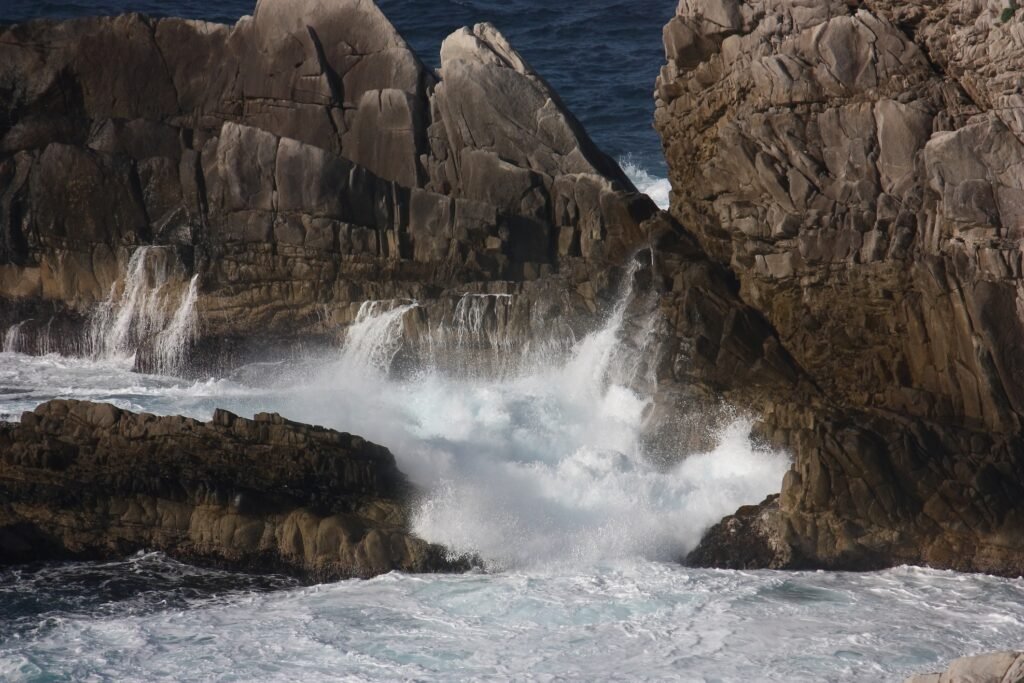
Rough Waves At Cape Ashizuri, Kochi, Japan
The Role of Seasonal Festivals
| Festival | Date | Signature Dishes |
|---|---|---|
| Katsuo Matsuri | Early September | Shaved bonito, kujira no shiruko soup |
| Awaoshi Autumn Fair | Mid-November | Earthenware-roasted millet, chestnut mochi |
| Tosa Clan Heritage Feast | Late February | Salt-preserved sardines, barley wine |
These events aren’t mere celebrations, they’re edible chronicles. At the Awaoshi Autumn Fair, you watch villagers pound rice cakes with rhythms passed down through generations. Each festival’s menu mirrors the region’s Japanese food culture timeline, where every ingredient tells a story of adaptation and reverence.
From mountain preserves to festival tables, Kochi’s food remains a living archive. Its flavors are both rebellion and homage—a cuisine that chose to endure, not evolve, proving isolation can birth culinary immortality.
Practical Tips for Your Own Kochi Food Adventure
Start your journey by learning Kochi travel tips to enjoy every taste. Visit in spring for fresh bonito and yuzu, or autumn for warm nabe hotpots. Summer festivals are great for street food, and winter for hot springs and shochu.
Be flexible when planning Kochi visit. Rent a car to see coastal towns like Tosa Bay. Trains are good for major sites, but mountain roads offer surprises. Stay at Yakumo Ryokan for fresh kaiseki meals.
- Download Google Translate’s offline mode for menus and conversations
- Pack reusable bags for market foraging adventures
- Reserve spots at kappo counters weeks in advance
Be spontaneous. Try morning fish auctions or yuzu-picking workshops. Arrive early at Miyazaki Sushi for a special experience. Street snacks are cheap, but kaiseki dinners are around $80 per course.
Enjoy Japanese food tourism by connecting with locals. Ask vendors about their craft and try Nagao Ramen like a local. Your adventure begins with an open mind and a hungry heart.
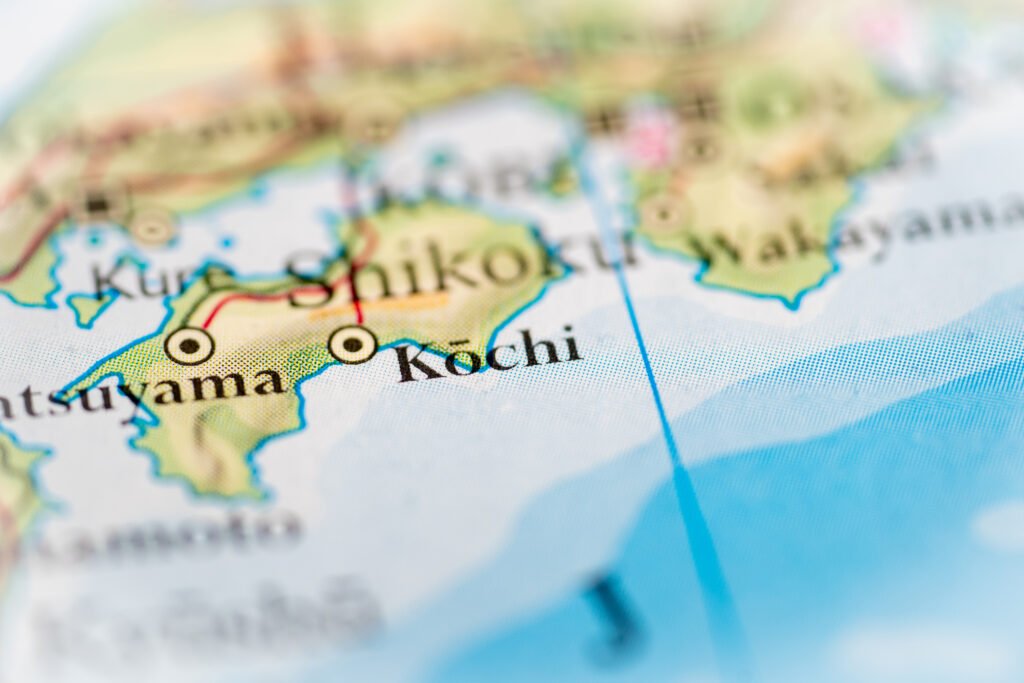
Kochi, Japan Highlighted On A World Map.
Conclusion: Why Kochi Will Forever Change Your Perception of Japanese Cuisine
In the shadow of Japan’s bustling cities, city’s culinary story unfolds like a hidden scroll. It reveals truths about authentic Japanese food few outsiders ever taste. Your journey here unveils layers of regional Japanese cuisine, each shaped by centuries of isolation.
The undiscovered Japan food here—like the delicate sear of bonito tataki or the citrusy burst of locally grown yuzu—proves that Japan’s culinary soul thrives beyond Tokyo’s neon lights.
Every bite in Kochi is a conversation with tradition. The fisherman guides you through the marbled textures of bonito, the sake brewer shares the legacy of 12 generations of carefully guarded yeast, and the yuzu farmer names aromas like a poet. Through them, you witness Japanese culinary traditions—alive, unfiltered, and deeply personal. This is food that demands your full presence: the sashimi melts in your mouth, the umami of mountain-grown vegetables lingers on your tongue, and every dish tells you a story etched in flavor.
Kochi’s magic lies in its resistance to homogenization. It’s where terroir whispers through every grain of rice and every ocean-caught morsel. To savor Kochi is to understand that Japanese cuisine isn’t a monolith but a mosaic of regions like this, where time moves to the tide’s rhythm. Try recreating this city’s flavors at home with this savory pork ramen recipe, but know that no kitchen can fully replicate the alchemy of place and passion here.
Your palate—and your perspective—are forever changed by Kochi’s unpretentious mastery. Here, you discover the true essence of Japanese cooking, untouched by fleeting trends. If you’re craving more than just a superficial taste of Japan, Kochi isn’t a side trip—it’s your roadmap. Before the world catches on to its secrets, you have the chance to uncover them for yourself. Your next culinary truth begins right here, where the mountains meet the sea.
